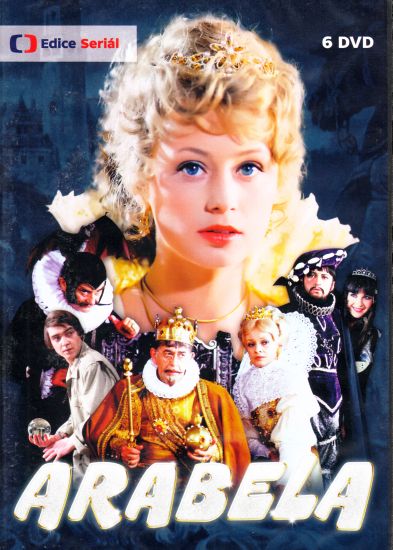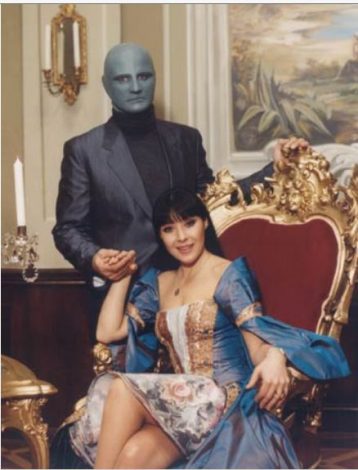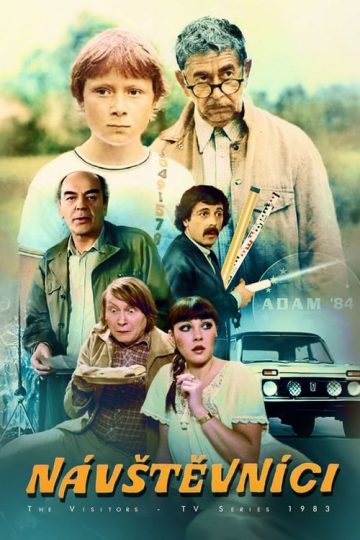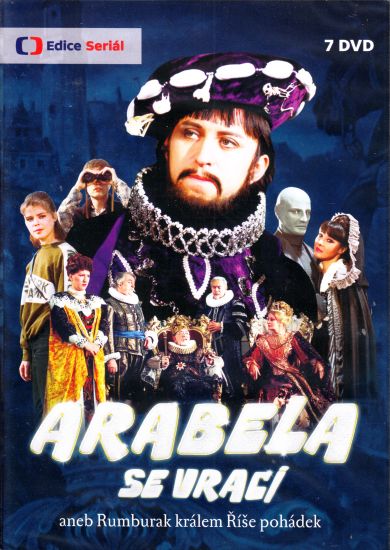 It’s a well-known fact that Czechoslovakia has perhaps the richest and most varied fantasy film tradition in existence. Standout Czech fantasy features include Karel Zemen’s THE FABULOUS BARON MUNCHAUSEN/BARON PRASIL (1962), Jaromil Jires’s VALERIE AND HER WEEK OF WONDERS/VALERIE A TYDEN DIVU (1970), Juraj Herz’s BEAUTY AND THE BEAST/PANNA A NETVOR (1978), Jiří Barta’s THE PIED PIPER/KRYSAR and Jan Svankmajor’s ALICE (1988). Less well known (to English speaking viewers) are the equally imposing achievements of Czech fantasy television, with the iconic 1979 miniseries ARABELA at the forefront in that particular category.
It’s a well-known fact that Czechoslovakia has perhaps the richest and most varied fantasy film tradition in existence. Standout Czech fantasy features include Karel Zemen’s THE FABULOUS BARON MUNCHAUSEN/BARON PRASIL (1962), Jaromil Jires’s VALERIE AND HER WEEK OF WONDERS/VALERIE A TYDEN DIVU (1970), Juraj Herz’s BEAUTY AND THE BEAST/PANNA A NETVOR (1978), Jiří Barta’s THE PIED PIPER/KRYSAR and Jan Svankmajor’s ALICE (1988). Less well known (to English speaking viewers) are the equally imposing achievements of Czech fantasy television, with the iconic 1979 miniseries ARABELA at the forefront in that particular category.
Divided into thirteen 29 minute episodes, ARABELA was scripted by Milos Macourek (1926–2002) and directed by Václav Vorlícek (1930-2019). Ingeniously juxtaposing a fairy tale universe and the bleak realities of Central Europe in the late 1970s, the program centers on various magical elements taken from European fairy tales (those of the Brothers Grimm and Hans Christian Anderson in particular), including a ring that can reorder reality, a flying suitcase and an overcoat capable of transporting its wearer from one world to the other. Macourek and Vorlícek juggle these elements in consistently inventive and unpredictable fashion, with a tone that adroitly balances carefree fantasy, gritty reality and pointed satire.
Furthermore, the program accomplishes all this without any of the overbearing political overtones you might expect from an eighties-era eastern bloc fantasy. ARABELA appears to have been exempted from the political dictates of Czechoslovakia’s Soviet overseers due to the fact that it was classified as a children’s series—although nowadays it would probably go over the heads of most adults.
The main characters include Karel (Vladimír Mensík), an academician who reads fairy tales on television each night, and inadvertently starts off an escalating series of complications by entering fairyland and shooting the wolf who’s supposed to threaten Little Red Riding Hood. There’s also Princess Xenie (Dagmar Patrasová, a major sex symbol in her native land who pushes the boundaries of children’s programming in the many revealing outfits she sports), who after spending time in the real world becomes determined to remake fairyland in its image, as well as the evil magician Rumburak (Jirí Lábus), who is scheming to marry Princess Arabela (Jana Nagyová), and the latter, an impossibly pure-hearted beauty who after a sojourn in the real world falls in love with Karel’s dashing son Petr (Vladimír Dlouhý). Animal guises are constants, with Rumburak frequently transforming into a crow and Karel spending a fair amount of time as a dog, as are flying people and objects (courtesy of that aforementioned suitcase), and special effects that are surprisingly impressive given the restraints, budgetary and otherwise, under which the program was made.
I’ll refrain from revealing how all these elements play out (which would be impossible to do in anything less than novella form),  but will express admiration for the program’s inspiration and audacity. Many subsequent films and TV shows (such as ABC’s ONCE UPON A TIME) have attempted a similar approach, but none have quite succeeded; the closest existing corollaries to ARABELA are the madcap fantasy novels of Tim Powers (such as THE ANUBIS GATES and LAST CALL), which have been deemed “unfilmable.”
but will express admiration for the program’s inspiration and audacity. Many subsequent films and TV shows (such as ABC’s ONCE UPON A TIME) have attempted a similar approach, but none have quite succeeded; the closest existing corollaries to ARABELA are the madcap fantasy novels of Tim Powers (such as THE ANUBIS GATES and LAST CALL), which have been deemed “unfilmable.”
Not everything in ARABELA works, alas. A brief sojourn in an “adult” portion of the fairy tale world, in which Fantomas and Frankenstein’s monster turn up, is intriguing but far too perfunctory (and this in a series notable for exploring its conception’s every imaginable permutation), and the final episode is unsatisfying, being riddled with implausibilities (I’d think that at such a late point in the series the characters would know better than to leave the magic ring unattended) and closing things out on a note of shockingly low key whimsy.
But ARABELA’s excellence is evident in how it continues to dominate the televised fantasy landscape outside its native land, and also within. One might expect all Czech children’s programming to adhere to a similarly high standard. One would be roundly mistaken.
Among the flood of Czech fantasy programs that followed in ARABELA’S wake was the six-part miniseries LUCY THE MENACE OF STREET/LUCIE, POSTRACH ULICE, a 1980 co-production with West Germany (where ARABELA was especially popular) that was later edited into the features LUCIE, POSTRACH ULICE (1984) and …A ZASE TA LUCIE! (1984). The show has no direct relation to ARABELA outside the presence of an uncredited Dagmar Patrasová as a store clerk, being a more overtly kid-friendly account of a little girl (Zaneta Fuchsová) shoplifting a box of putty whose contents take the form of mischievous Gumby-like Claymation personages. Energetically directed by the Czech new wave maestro Jindrich Polák (of innovative classics like A GAME WITHOUT RULES/HARA BEZ PRAVIDEL, 1967, and TOMORROW I’LL WAKE UP AND SCALD MYSELF WITH TEA/ZITRA VSTANU A OPARIM SE CAJEM, 1977), it was well received, but suffers from a decidedly uninventive script by Polák and Ota Hofman (scripter of quite a few classic Czech fantasies, the abovementioned BEAUTY AND THE BEAST included) with too many annoying kid show contrivances.
The same is true of Polák and Hofman’s 1986 follow-up THE OCTOPUSES FROM THE SECOND FLOOR/CHOBOTNICE Z DRUHEHO PATRA, which tells a very similar story with much of the same cast. This one, mercifully, only lasted four episodes, which were once again edited into two feature films: THE OCTOPUSES FROM THE SECOND FLOOR/CHOBOTNICE Z DRUHEHO PATRA (1987) and MERRY CHIRSTMAS OCTOPUS/VESELE VANOCE PREJI CHOBOTNICE (1987). It features a brother and sister (the latter played, again, by Zaneta Fuchsová) who befriend a pair of friendly clay masses that emerge from a pollution-strewn ocean. Final verdict: more of the same, although the show did help cement the Polák-Hofman team in the top echelons of Czech TV production, and as the foremost rivals of ARABELA’s dynamic duo Václav Vorlícek and Milos Macourek.
Vorlícek and Macourek put out the ten part miniseries HAMSTER IN A NIGHTSHIRT/KRECEK V NOCI KOSILI in 1988. It’s rather inspired, but suffers from an overly convoluted and esoteric set-up involving a magic nightgown that inspires elaborate dreams in the minds of its wearers, who in those dreams conjure up nifty inventions that defy the laws of physics. This results in some pretty amazing sights, including a flying building and an indoor snowstorm.
 The foremost TV follow-up to ARABELA came from Mssrs. Polák and Hofman, who in 1983 graced us with THE VISITORS (NAVSTEVNICI). It jettisons fantasy in favor of time travel-themed sci fi, but appears to have been consciously designed to recall ARABELA, featuring as it does a number of its cast members—including Dagmar Patrasová, who once again parades around in a variety of revealing outfits.
The foremost TV follow-up to ARABELA came from Mssrs. Polák and Hofman, who in 1983 graced us with THE VISITORS (NAVSTEVNICI). It jettisons fantasy in favor of time travel-themed sci fi, but appears to have been consciously designed to recall ARABELA, featuring as it does a number of its cast members—including Dagmar Patrasová, who once again parades around in a variety of revealing outfits.
She plays one of a time traveling quartet summoned by the architects of a bizarre future civilization. This future is threatened by a rogue asteroid, and humanity’s only hope of staving it off is via an equation written by one Adam Bernau, the architect of this civilization, when he was a child. Hence the time travel gambit, whose participants are to travel back to the year 1984 and retrieve the 10-year-old Bernau’s exercise journal. But what was intended as a half-day expedition quickly becomes a protracted ordeal, as upon arriving in 1984 this intrepid foursome encounters one complication after another, ranging from a suspicious carnival operator whose truck they inadvertently crash to a futuristic transmitter whose heat waves evaporate an entire lake.
The consistently inventive and unpredictable narrative will strike a chord with ARABELA’s viewers, as will the lighthearted yet gritty atmosphere. Stop motion animation by the incomparable Jan Svankmajor is also put to good use in each episode, in shots of futuristic capsules that transform into grand meals and other marvels. Plus, several modern innovations are foreseen, such as an electronic device capable of holding an entire library’s worth of data and a time-travelling car (introduced a full two years prior to a certain movie containing the words “Back” and “Future” in its title).
And the ARABELA craze didn’t stop there. A middling TV movie spin-off, RUMBURAK, appeared in 1984, courtesy of Vorlícek and Macourek, that was centered on the character of Rumburak the evil wizard. Having been felled at the end of ARABELA, Rumburak now finds himself trapped in the real world, where computers and machinery threaten to usurp his fairy magic. The idea of pitting magic against technology is a good one, and results in some fun concepts (such as a voice box that Rumburak, in his crow guise, uses to translate squawks into human speech), but it’s not taken far enough, with RUMBARAK registering as an unsatisfying trifle.
There was also, inevitably, ARABELA RETURNS/ARABELA SE VRACÍ, from (once again) Vorlícek and Macourek, which appeared in 1993. Running a whopping 26 episodes, ARABELA RETURNS did its best to recapture the elusive magic of its predecessor but fell short, in both quality and popularity.

Here Jana Nagyová is replaced by Miroslava Safránková (the sister of Libuse Safránková, who overdubbed Nagyová’s voice in ARABELA) as Arabela, who assumes a minor supporting role. Most of the rest of ARABELA’s cast return, including Dagmar Patrasová as Princess Xenie, whose outfits are even skimpier (if that’s possible) than those she wore in the initial series. The twisty storyline is much like that of ARABELA, as is the look, style and attitude.
But alas, the pacing is a bit more sluggish than it was before, the narrative convolutions a shade more conventional and the reality-fairy tale ratio far less harmonious. Those are all minor complaints, but they add up, and result in a series that, to those familiar with its predecessor, disappoints.
Another unsatisfying fact of life is the unavailability of ARABELA and its follow-ups in the English speaking world. Nearly all the abovementioned programs have been released on DVD throughout Europe and Asia, but as for home video and/or streaming in the US, Canada or the UK (pirated versions aside) there’s nary a trace. I fully believe there’s interest to be had, and money to be made, from ARABELA in the western world, but like the denizens of the fairy world it depicts, the realities of the show’s passage from its own rarified land into ours are evidently far more arduous than they might seem.
